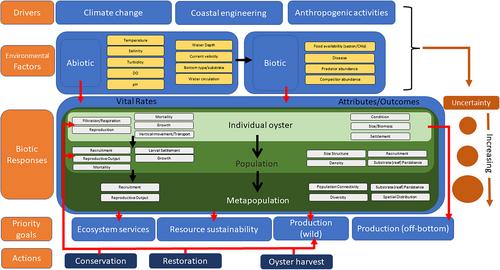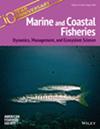The use of conceptual ecological models to identify critical data and uncertainties to support numerical modeling: The northern Gulf of Mexico eastern oyster Crassostrea virginica example
Abstract
Objective
Increasing reliance on numerical simulation models to help inform management and restoration choices benefits from careful consideration of critical early steps in model development. Along the northern coast of the Gulf of Mexico, the eastern oyster Crassostrea virginica fulfills important ecological and economic roles. Using the eastern oyster as an example, we draw on several recent frameworks outlining best practices for model development and application for restoration, conservation, and management.
Methods
We identify priority model questions, outline a conceptual ecological model (CEM) to guide numerical model development, and use this framework to identify uncertainties and research needs.
Result
The CEM uses a nested design, identifying explicit vital rates, processes, attributes, and outcomes for the species (oysters), population, and metapopulation (i.e., network of populations) levels in response to drivers of species, population, and metapopulation changes and changing environmental factors. Most management actions related to oyster restoration and harvest affect population attributes directly, but many coastal management actions and changes (i.e., climate change and coastal and water resource engineering) impact environmental factors that alter vital rates and attributes of oysters, populations, and metapopulations.
Conclusion
Investment in studies targeting individual oyster- and population-level multi-stressor responses (filtration, respiration, growth, and reproduction) and improving hydrodynamic and environmental models targeting drivers that influence metapopulation vital rates and attributes (i.e., connectivity and substrate persistence) would contribute to reducing uncertainties. Development of numerical models covering the entire oyster life cycle and connectivity of populations using hydrodynamic models of current and predicted conditions to provide key abiotic and biotic factors influencing larval movement, recruitment, and on-reef oyster vital rates would assist in balancing the goals of conservation, restoration, and fisheries management of this foundational estuarine species.


 求助内容:
求助内容: 应助结果提醒方式:
应助结果提醒方式:


